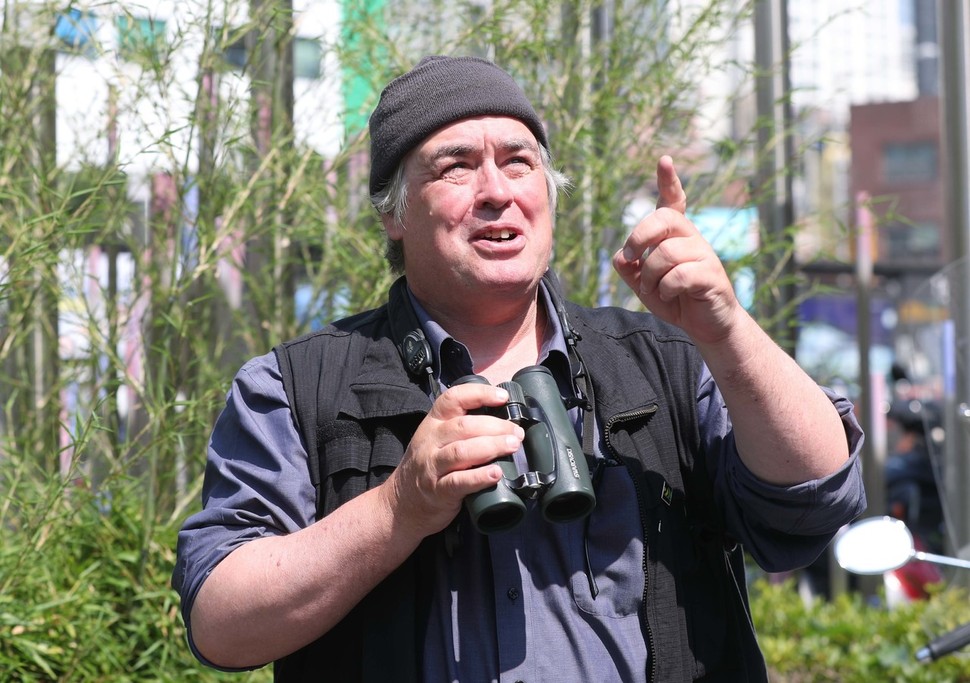 |
|
Dr. Nial Moores, founder and CEO of the conservation organization Birds Korea, talks about his experiences regarding Noth Korea’s coastline and wetlands on June 1 in Seoul before heading to North Korea once again for an observation excursion. (Baek So-ah, staff photographer)
|
British ornithologist Nial Moores has glimpsed parts of North Korea totally unknown to many South Koreans
Even when inter-Korean tensions are low and relations are relaxed, it is rare for South Koreans to venture into militarily sensitive areas, such as North Korean coastlines. However, there is a person who has visited North Korea’s coastlines and swamps and wetlands eight times, and recently, at that. Dr. Nial Moores, 55, is a British citizen but has spent the last 20 years studying birds on the Korean Peninsula. Founder and CEO of Birds Korea, He is often praised as someone who “knows Korea’s birds better than Koreans.” The Hankyoreh was fortunate enough to have a conversation with Dr. Moores via email regarding his expertise and experiences.
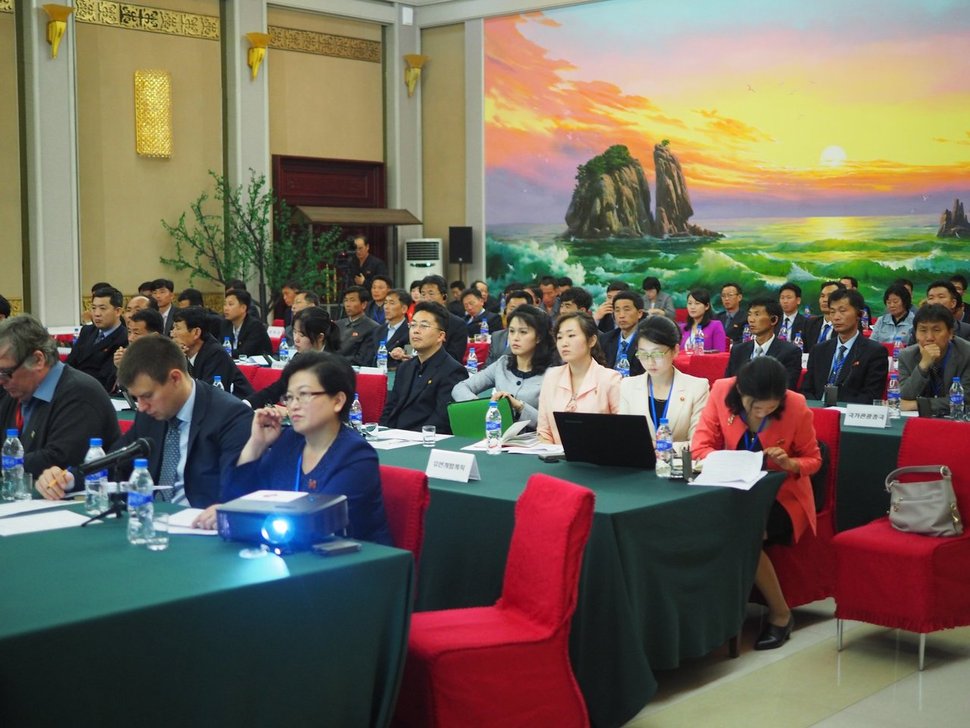 |
|
A workshop to celebrate North Korea’s accession to the Ramsar Convention on Wetlands was held in Pyongyang on May 16. (provided by Hanns Seidel Foundation)
|
Hankyoreh (Hani)i: On May 15, a national workshop was held to celebrate DPRK’s accession to the Ramsar Convention on Wetlands but on that day the inter-Korean high level talks were unilaterally cancelled by the North. Trump’s letter to quit deals with the North followed. What was the atmosphere during your visit to North Korea?
Nial Moores: We arrived in Pyongyang on May 15, and the main meeting to celebrate their accession to the Ramsar Convention was on the 16th, when the formal accession process was completed. Approximately 130 people were in attendance, including relevant officials from all over the DPRK (North Korea hereafter) and a few diplomats. The atmosphere was good, and a little unlike previous visits, several people that we had most contact with seemed quite positive about the future, talking about improved possibilities “when” the situation improves. I was not aware at the time that any talks had been cancelled, but several people signaled that they believed their
leadership would help lead their nation towards something better.
Hani: Do you think that accession to the Ramsar Convention is a good sign for the North becoming more open to the international community and environmental concerns?
Moores: Yes, I think that accession to Ramsar and joining the East Asian-Australasian Flyway Partnership is a positive step forward and a sign that North Korea is trying to open-up further to greater collaboration with the international community to deal with pressing environmental issues.
There is one major caveat for those wishing to engage more deeply with North Korea. To have any kind of relationship and influence, international bodies will need to show respect to North Korea in more or less the same way that North Korea is expected to respect other nations. To be absolutely clear, I do not mean showing respect in the form of open reverence for their leadership - and in eight survey visits, I have not bowed and I have not been asked to bow even once to a statue of their leadership or to repeat any political slogans.
Instead, what I mean by showing respect does not feel all that different to the respect I am expected to show – as someone born elsewhere – when I have worked in Vietnam, Japan or even here in South Korea. Outside organizations and experts can be accepted and respected there as experts in their own field – but they will very likely not be accepted or respected as experts in “things North Korea.”
As an example of openness to collaboration based on mutual respect of this kind, our main counterpart (in The Ministry of Land and Environment Protection) told us explicitly that our surveys and our advice on Mundok and Rason had persuaded their nation to choose these two sites as their first Ramsar sites (they were not the first choices even as recently as in March 2017). To me, this is a clear signal of trust in our survey data; supported over several years by multiple efforts by multiple bodies (directed by the Hanns Seidel Foundation) including the IUCN, which MoLEP joined last year.
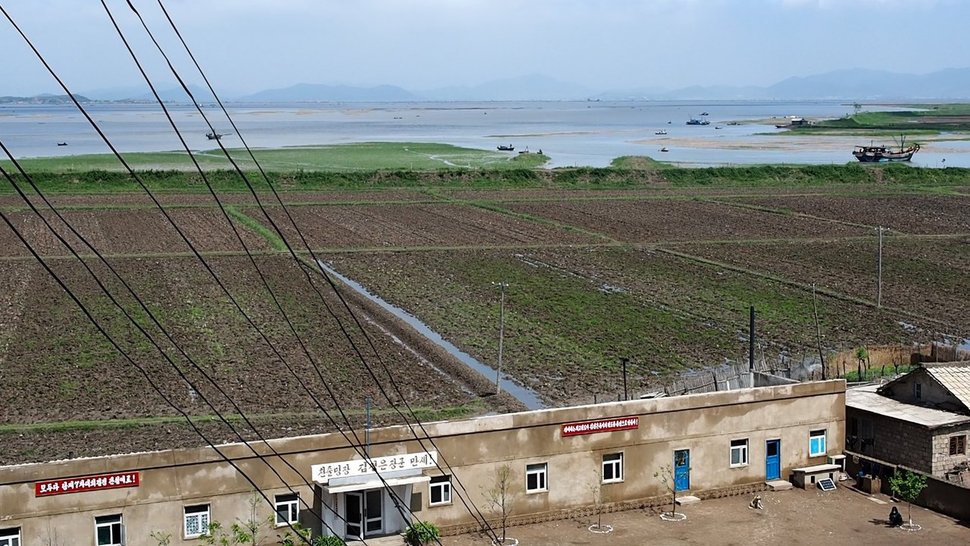 |
|
A conservation for birds in Mundok County, North Korea (provided by Hanns Seidel Foundation)
|
Moreover, although recent decisions look to be signs of rapid progress, it also seems that there is a fairly long history in North Korea of concern for the environment – just very little capacity to do what is needed (little money and dense human population in lowland areas). North Korea by itself already designated 18 or 19 Migratory Bird Reserves in the 1990s; and the report (attached) entitled “INTERNATIONAL ENVIRONMENTAL COOPERATION OF THE DEMOCRATIC PEOPLE’S REPUBLIC OF KOREA REPORT PREPARED FOR THE DMZ FORUM APRIL 2015” by Dr. Kim Rakhyun, includes the following statement:
“In the field of sustainable development, however, the DPRK’s cooperation with other states and international organizations has apparently improved over time. While lacking in technical and financial capacity, the DPRK has signed on to a number of international environmental agreements and implemented various measures to fulfill its obligations as a contracting party. Some commentators have observed that the DPRK’s reporting documentation to the three Rio Conventions, for example, has steadily improved in quality and detail over the past decade as a consequence of its institutional participation.”
Hani: Was the national workshop successful? Did high-ranking officials attend? Did any NGOs or amateur birders show up?
Moores: We were told several times that the workshop on May 16 was very successful, and that many officials were envious of the high regard given to Mundok and Rason at the meeting. The Hanns Seidel Foundation (Korea office) has helped initiate several workshops of this kind in North Korea, annually since 2015. These were the third and fourth events I have attended (first two were in Pyongyang in May 2016; then one at Samilpo, Gangwon in March 2017) – and I believe that this one attracted the greatest interest and the best media coverage, e.g. by State television; Pyongyang Times, etc.
As far as I understand it, there is no genuine civil society or environmental NGO in North Korea; and certainly no amateur North Korean birders, even though birds are often featured in art work and are mentioned in news bulletins; and even though the ornithologist Professor Won Hong-koo (father of Won Pyong-oh) is still a well-known figure, having had a movie made about him. The only in-country amateur birders are likely to be foreign diplomats and agency staff. None of these attended.
Everything is controlled and run by the state. The Nature Conservation Union of Korea (NCUK) describes itself as an NGO – and is a long-time partner to the IUCN - but it is not an NGO in any sense that anyone from South Korea would easily recognize. Rather, they are a government body with a little less authority and influence than more formal government bodies that include the Ministry of Land and Environment Protection.
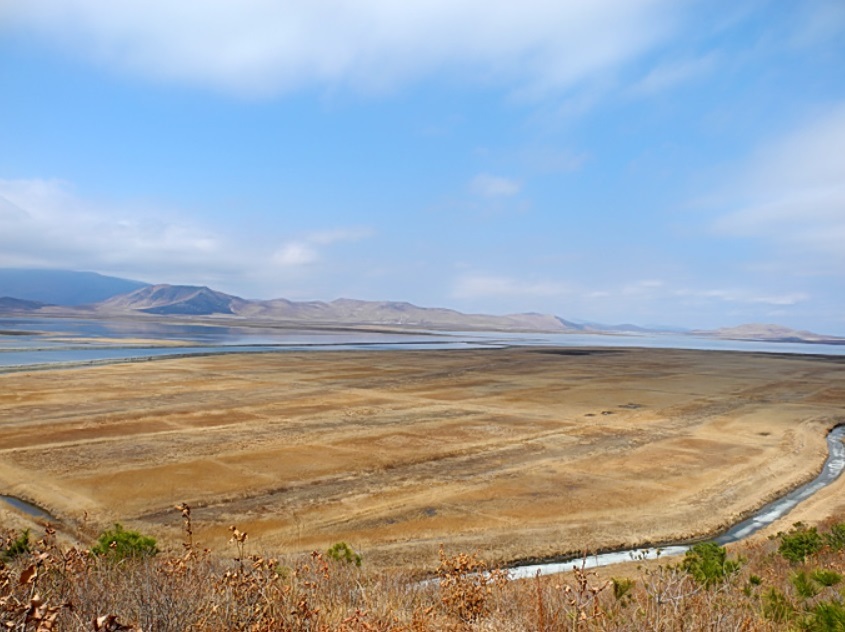 |
|
Rason Migratory Bird Reserve along the Tumen River in North Korea. The photograph was taken in Mar. 2014. (provided by Hanns Seidel Foundation)
|
Hani: How are field visits conducted? Many Koreans are curious and even envious of your visits.
Moores: I have conducted eight bird and wetland surveys in North Korea so far (four in Rason; four in other areas on the west and east coasts), all as an ornithologist contracted by the Hanns Seidel Foundation (Korea office). Rason later this week will be the ninth. Most surveys are for 5-8 days, with 2-3 extra days for travel and meetings. All have been initiated and funded by the Hanns Seidel Foundation Korea office, in cooperation with MoLEP and authorities in Rason.
Each time, dates are discussed well in advance through established channels (e.g. HSF, the Ramsar Secretariat and the DPRK mission in Switzerland who then communicate with MoLEP); and each time, we must register in detail the equipment we want to take in. With the proper permissions we can bring in and use our telescopes and cameras there.
In the last survey, we had two days of survey at Mundok; and then visited five or six wetlands on the east coast (from Sijeung Lake in the south to Hamhung in the north). At first, there were two teams at Mundok: one focused on management (including representatives from the IUCN and East Asian Australasian Flyway Partnership), the other on biodiversity. For the east coast, everyone was part of the bird survey: a driver; three officials from MoLEP; two local party officials; three researchers from the State Academy of Sciences (there to learn more about identification and survey methods); Dr Bernhard Seliger (HSF representative and also Birds Korea member); and myself.
At every site (apart from Rason) there are always strict restrictions on where we can go (and sometimes, where we can look!), with days of preparation spent by MoLEP in agreeing permission to coastal areas or in crossing from one village’s jurisdiction to another, even in so-called protected areas.
Part of the argument we have been told for restricting access in this way is that bad foreigners have tried to embarrass North Korea in the past. More likely is that the military are simply extremely powerful and they are everywhere. It is likely the military that are extremely reluctant to allow people to visit anywhere that might reveal any secrets – not just foreigners, everyone.
All the same, with each visit to the same site access restrictions tend to become a little less strict, as the area and process (on who to contact) becomes better known to MoLEP, and trust is built up.
However, the survey process is always very frustrating – as we are so often blocked from accessing some of the best-looking areas of habitat.
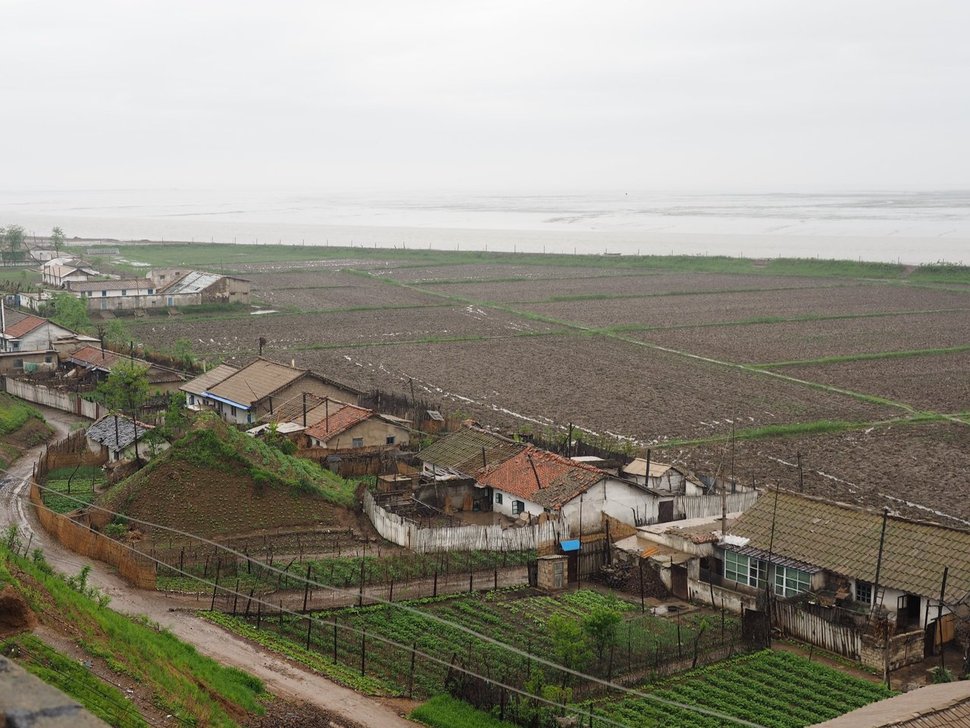 |
|
Mundok Migratory Bird Reserve near the mouth of the Chongchon River, in North Pyongan Province. (provided by Hanns Seidel Foundation)
|
Finding previously unrecorded species
At the same time, there is always much to learn. During these eight surveys we have helped identify several internationally important wetlands and coastal areas; and we have found almost 300 species of birds already, including several species previously unrecorded or previously not recorded breeding in North Korea before. The surveys help us to improve understanding of the birdlife and the environment of the DPRK, and also make it increasingly easy to compare the status of birds and their habitats in South and North Korea.
I think it helpful to add that for our work, we have been thanked sincerely by those we work with in North Korea - for sharing our count data, insights and images freely and quickly. We very much hope that our work and open sharing of data can also help people in the ROK understand a little bit more about the environment north of the DMZ too.
Hani: How is bird watching viewed by officials or ordinary people? Are they eager to preserve migratory birds and conserve nature? Are they eager to learn about rare bird species and ecological relationships?
Moores: Yes, people we have met in MoLEP and the SAOS are very interested in learning about birds and are very keen to conserve their nation’s biodiversity. The head of the MoLEP section we work with is very knowledgeable already – about ecosystems, ecosystem services, agro-forestry etc. Although there is no freedom in their society as we would understand it, everyone we meet shows strong interest in data and in discussing key sites.
As in every country that I have visited over the years, people are almost always interested to see the birds that are found in their local area. The attitudes of those involved in the surveys are similarly always positive. Local “ordinary” people are much harder to assess. Most are extremely busy simply trying to earn their livelihood, and are reluctant even to look our way. And of course there is not the freedom to talk openly with local people – even though we occasionally exchange greetings in passing.
 |
|
Members of international organizations such as the Hanns Seidel Foundation meet with residents of Mundok County, South Pyongan Province, to discuss conservation methods for the region’s birds and neighboring wetlands. (provided by Hanns Seidel Foundation)
|
Field visits
Hani: What are your impressions of Mundok and Rason MBR?
Moores: Although I had read articles and seen images and video, I first saw the Chongchon Estuary (Mundok) with my own eyes from the airplane when flying from Beijing to Pyongyang in May 2016. It was low tide, and the estuary looked wonderful, with a large open river without any estuarine barrage; huge vegetated tidal-flats; rows of sandy islands seaward; and in the far distance, small rocky islets that I had read support breeding Black-faced Spoonbills and Chinese Egrets. Immediately I thought of Saemangeum, before seawall closure; and I imagined how the Geum and Nakdong Estuaries must once have looked.
Rason is remarkable because of the diversity of habitat types. Within a single view you can see forested hills; grassland; rice-fields; lakes and reed-beds; and a quite beautiful coastline. Although much of the area has been degraded in one way or another (through grass-burning on hillsides; and through conversion of marsh to rice-field) it still is very bird-rich.
 |
|
A North Korean official affiliated with the Mundok Migratory Bird Reserve looks through an illustrated archive for the name of the bird species he just observed through a field scope. (provided by Hanns Seidel Foundation)
|
Hani: You already visited Rason MBR in 2014, were there any changes?
Moores: Change seems to be slower than here in South Korea. However, even in the last four years at Rason, we have seen the loss of a small area of tidal-flat; and the conversion of some reedbed (a very important habitat) into fish-ponds, done by a Chinese company.
In addition to the great international importance of the area for water birds and seabirds, one of the reasons that we pushed so hard for Ramsar designation at Rason was that there needs to be new tools and additional support to conserve habitats there. The area is far from Pyongyang; and there are massively ambitious development proposals that require funding from China and Russia. People in Rason will need as much technical and perhaps logistical help as they can get if they are to conserve the area’s ecological value.
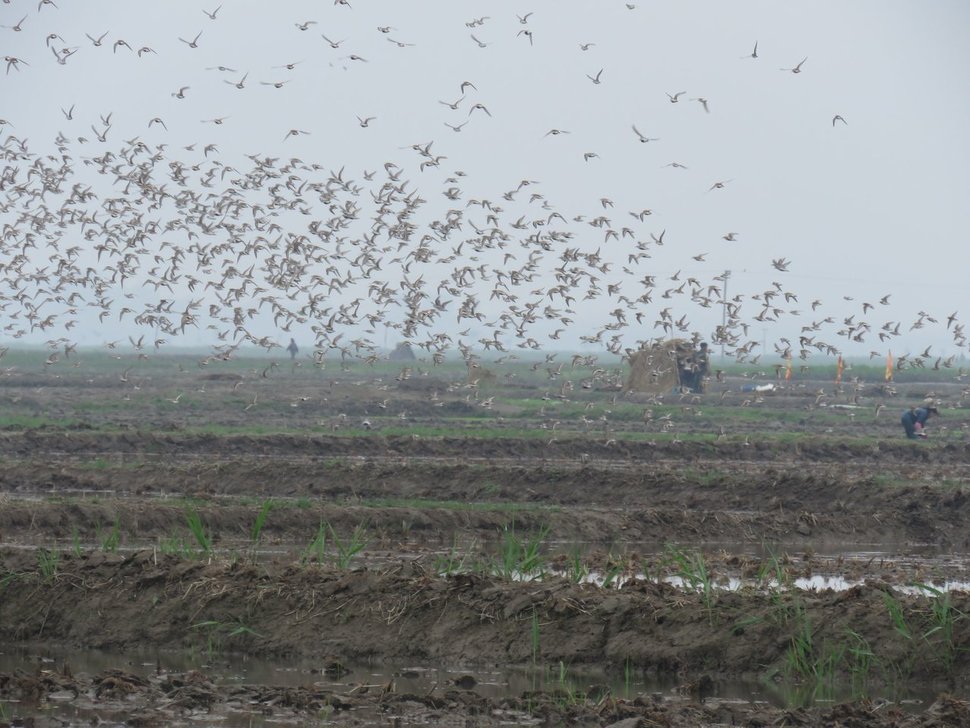 |
|
A flock of sandpipers and waders flying above a farm in the Mundok Migratory Bird Reserve. The birds are similar to the ones observed near the Saemangeum tidal flat observed before the region’s land reclamation. (provided by Hanns Seidel Foundation)
|
Hani: We could not find any information from the Ramsar website about these two sites. Could you briefly describe them?
The Ramsar site at Mundok covers about 3500ha (35 square kilometers) of vegetated tidal-flat and intertidal river flats and shallows and 250ha (2.5 square kilometers) of adjacent rice-fields. Large parts of the tidal-flats are covered in reeds and some kind of sedge. The area is important for shorebirds, and even more so for Swan Goose – with 40,000 (more than half of the world population) counted there in recent years.
Although there is not supposed to be any fishing there, there is a lot of fishing from boats and along riverbanks – and a lot of disturbance caused by people. Much of the discussion about the site has been on finding ways to supplement the income and food needs of local people, so that they can reduce pressure on the natural resource base.
There is a satellite image of Rason Ramsar site at: https://rsis.ramsar.org/ris/2343
The main site comprises three shallow lakes (two freshwater, one brackish) and adjacent areas of rice-field and reed bed. However, at least some of the special value of the area to birds is the geographical location (on a major branch of the Flyway) and the area’s connectivity to other habitats.
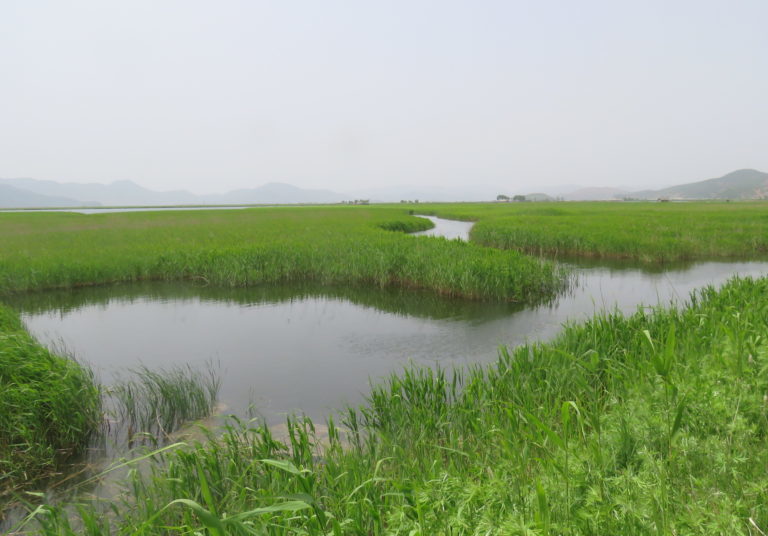 |
|
Kumya Migratory Bird Reserve, along the coastline of North Korea’s South Hamgyong Province, is an internationally significant region of wetlands (provided by Hanns Seidel Foundation)
|
Hani: Could you compare North Korean sites with corresponding South Korean sites with respect to species, landscape, use of natural resources and conservation policy?
Moores: It is difficult to make direct comparisons, because development and infrastructure are so very different between North and South Korea. The two nations are at very different stages in their economic and social evolution.
In the North, there is still almost no concrete; there is very little plastic; there are no street lights in rural areas; few dams or sluices. And because there is very little machinery, there are often manyh people everywhere during the day – farming by hand and fishing. Some areas look beautiful and natural, other areas look denuded, with degraded forests and eroded hillsides. People still need the land and waters where they live to eat and drink and wash.
How South and North Koreans differ in their view of nature
The situation in South Korea is very different of course. People sacrificed much and worked hard to rebuild the nation and to make the country economically strong. There have been many achievements (both economic and environmental, in controlling air and water pollution and in reforesting the mountains). Awareness of the environment is now high. However, most people appear to consider the land and the waters where they live only as a background to their daily lives.
Away from the beautiful mountains, in much of the lowlands there is now an excess of infrastructure and resource extraction. The air is clean, but there is now so much plastic and garbage in the environment – black vinyl sheets once used for growing potatoes now hanging like dead crows from trees; transparent vinyl houses for growing strawberries, with broken pipes and garbage piles lying next to them. The coastline here too is now largely concrete-lined, as are rivers, nowadays more than anywhere else I have visited (Europe, North America and other parts of Asia, perhaps with the exception of Japan).
There are now dams almost everywhere too, even of quite small streams. And because of the availability of heavy machinery, you see few people in the fields or in rivers (apart from recreational fishers or people camping next to their camper vehicles).
Many of these kinds of changes in South Korea have been ongoing for decades and are still ongoing now, as everyone can see. Some of the changes were essential; many were valuable. But at least in this century, there has been much construction and development that appears to me as an ecologist and as someone who loves this nation as simply development for development’s sake, providing few benefits to ordinary people and degrading the nation’s natural beauty.
The now sterile and dead Saemangeum and the Four Rivers project are probably the most famous and awful examples of this kind of unsustainable development here in South Korea, but our small organization has also documented the decline of many formerly common species as hundreds of smaller natural areas have also been bulldozed and degraded: tree sparrows, barn swallows, brown shrikes, mallard, shorebirds - all have declined and all are indicating the loss of ecosystem productivity.
Therefore, many of us now worry deeply that some in the construction industry here might want to repeat this kind of development model in North Korea once peace and reunification are achieved – starting with valuable projects but continuing on until almost everywhere has been converted from nature into artificial landscapes.
In this understanding of stage of evolution, I would compare Mundok to Saemangeum pre-seawall closure, or the Seocheon coast of the Geum estuary perhaps 60 or 70 years ago. Both are currently important for shorebirds (the Geum Estuary more than Mundok); and both support Swan Geese (now only 30 or 40 in the Geum, comparted to 40,000 at Mundok). But Mundok looks and feels rural.
Rason is perhaps closer in feel and abundance to how I imagine the lagoons and coast of Gangwon Province, like Hwajinpo Beach, would have been 70 or more years ago, with flocks of swans and tens of thousands of ducks
Will Rason still be like this if highways and street lights and ecology museums and aquaria and parks and pensions have been constructed all around it as at Hwajinpo Beach now?
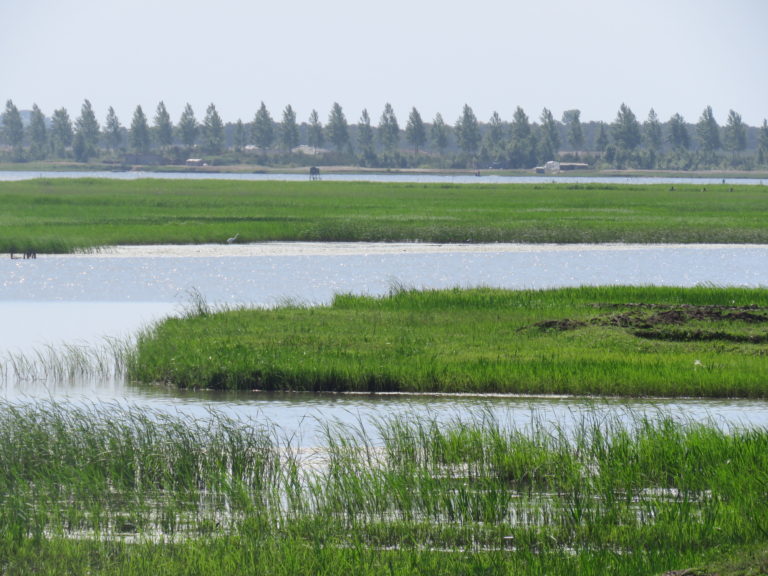 |
|
Gwangpo Lake, in South Hamgyong Province, is one of North Korea’s definitive reserves for migratory birds. (provided by Hanns Seidel Foundation)
|
Birds found in North Korea
Hani: What are the noteworthy bird species you observed at the sites?
Moores: This is too difficult to answer in brief, so please let me answer in three parts.
First, it is remarkable that species like skylarks and brown shrikes – now lost as a breeding species in much of South Korea – are still common in North Korea. They indicate clearly that it is the intensification and industrialization of agriculture that has been responsible for their demise in South Korea.
Second, although we have been able to access only a few stretches of coast in North Korea, all the East Sea areas we have been able to survey (in Rason, near Hamhung, in Gangwon) support large numbers of sea ducks, grebes and loons – often in much bigger numbers than in the ROK. These bird species prey on different species of marine life – and indicate that the marine ecosystem in the North is still quite healthy, diverse and naturally productive. Notably too, there are rather few gulls there when compared to the ROK. As many of these gulls feed on waste from fishing, the most likely explanation for their scarcity in North Korea is the lack of waste there.
Finally, I have yet to see some of the amazing bird concentrations in North Korea that I have seen in South Korea. I have not seen any huge flocks of Baikal Teal or geese; and have not yet seen flocks of 100,000 shorebirds as I used to see in Saemangeum. It is difficult to know why this is. Perhaps we have not been to the right areas at the right time of year; or perhaps the by-hand agriculture means there is little waste and too little spilt rice left for big concentrations of geese? More research is needed to help reveal the answers to such questions!
[%%IMAGE11%%]
Hani: You are heading for Rason again, what are you going to observe this time?
Moores: Our focus will be on breeding birds and on amphibians. The political situation allowing, we also want to use the visit to help promote awareness of the Ramsar designation of Rason’s wetlands; and by publicizing the importance of the area, perhaps we can also start to encourage other people to visit there, either for research or even for recreational bird watching?
Future inter-Korean cooperation
Hani: As inter-Korean tensions relax and many cooperation projects are expected to be devised by NGOs in the near future, do you have any corresponding ideas or plans?
Moores: For many years now, Birds Korea has been building up information to use in a “Status of Birds” report to cover the whole of the Korean Peninsula. This report would bring together key findings on every regularly occurring bird species and try to map their distribution and abundance and to identify drivers of decline; e.g. to suggest reasons why species like the Brown Shrike is still common in North Korea but has become so rare in South Korea; to identify which species are likely increasing or decreasing because of climate change; and which are increasing or declining because of some other factors.
Although we produced one simple version of this report in 2014 covering only South Korea, we are still a very long way from being able to complete this report. We therefore are seeking collaboration with willing partners in both South and North Korea. In the short term, we would hope that this report could help to support biodiversity conservation policies and actions throughout all of Korea; and that longer term, the process and report will also help to provide a valuable baseline for future generations of Korean researchers and decision-makers.
[%%IMAGE12%%]
Hani: Do you think that North Korean officials or NGOs are ready to accept South Korean NGO’s offers in the field of bird conservation? What kind of cooperation are they most interested in?
Moores: If sanctions and decision-makers allow, then as long as respect is given (as explained above); as long as the intentions are well-meant; as long as the needs of the North are being addressed, then I think, yes, relevant bodies in North Korea would welcome support and collaboration in the field of bird conservation from more people here in South Korea. Of course, no nation is entirely homogenous and there might be some in the North, e.g. in the military, who would interpret “juche” differently.
As we have done, the best way is to ask counterparts what they need; and then to modify their requests in ways that most seem fit to your own organizxation or department. At this stage, small steps are much better than big ones: increasing information exchange on migratory birds; sharing images of birds for them to use in materials like their Red Data Book; providing materials for field-guides or for materials aimed at schoolchildren which can be amended and used in ways they need. At this time, their immediate needs are great. But over time, these kinds of exchanges should become more equal and balanced and two-way.
[%%IMAGE13%%]
Hani: Any other comments for South Koreans who are interested in bird conservation in the North?
Moores:Bird conservation means the conservation of birds and the natural productivity of the habitats they depend on: the forests, the wetlands, the seas and islands. Bird conservation is therefore in the interests of people and in the national interest of each nation – as ultimately we humans all depend on the same natural resource base for our own health, well-being and food security.
And here in South Korea as in North Korea, 90 percent of all bird species are largely migratory. This means that for any Korean bird conservation organization like Birds Korea to be successful in our work, we have to work here in South Korea and as conditions allow, also in North Korea –in the same way that we work already with organizations and experts in other nations along the migration routes of these species, whether in Alaska or in New Zealand.
Migratory birds know no national boundaries of course and they belong to no single country or place. Sometimes we humans envy their freedom of flight. While being mindful of the real pain of war and division, it is also sometimes helpful to go one step further in our own minds –and to perceive the world like a flying bird does, as one unit, all undivided, and interconnected. And through imagining this unified world, perhaps it also starts to become a little easier to understand that conservation work for migratory birds can also help to unite more of humankind too?
[%%IMAGE14%%]
By Cho Hong-sup, Environment Correspondent
Please direct comments or questions to [english@hani.co.kr]

















